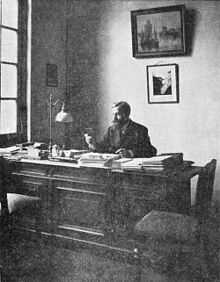Emmanuel de Martonne
| Emmanuel de Martonne | |
|---|---|
 Emmanuel de Martonne, taken before 1929 | |
| Born |
1 April 1873 Chabris, France |
| Died |
24 July 1955 (aged 82) Sceaux, France |
| Nationality | French |
| Occupation | Geographer |
Emmanuel de Martonne (1 April 1873 – 24 July 1955) was a French geographer. He participated in the Paris Peace Conference.
Early life and education
He was born on 1 April 1873 in Chabris, Indre, France,[1] and was the son-in-law of Paul Vidal de la Blache.[2] In 1882, he entered the École Normale Supérieure.[3] He graduated three years later with a degree in history and geography.[1] After that, he worked with Ferdinand von Richthofen and Albrecht Penck.[1]
Career
In 1899, de Martonne became a professor at the University of Rennes. In 1905, he started at the University of Lyon, and four years later at the Sorbonne.[4]
During the Paris Peace Conference after World War I, he was an adviser of Minister of Foreign Affairs André Tardieu and Prime Minister Georges Clemenceau,[5] and he also lobbied for the return of Alsace-Lorraine to the French.[6] De Martonne was also secretary of the Comité D'études, which worked on fixing boundary issues following the war, especially in Romania and the Balkans.[5][7] He was familiar with Central Europe and Romania, as he had conducted studies in the Southern Carpathians earlier in his life.[5]
After that, he taught at the University of Cluj in 1921.[8] He died on 24 July 1955 in Sceaux, a commune near Paris.[1]
Awards and honors
He became an honorary member of the Geographical Society of the USSR in 1933.,[9] and, from 1938 to 1952, was president of the International Geographical Union.[9] He was awarded the Cullum Geographical Medal in 1939, and the Victoria Medal in 1950.[1][10] He became a member of the French Academy of Sciences in 1942.[9]
Publications
In 1909, he published the first edition of his book Traité de géographie physique: Climat, Hydrographie, Relief du sol, Biogéographie. It contains 396 three-dimensional, painstakingly researched illustrations and maps. It covers many aspects of geography, including different map projections, the geographic coordinate system, physical geography, climate, hydrography, erosion, glaciers, and biogeography.[11][12] The second edition was published in 1913, and the third in 1920.[4]
He published Les Alpes: Géographie générale, a study about the Alps, in 1926. This led to the "De Martonne aridity index".[13]
References
- ↑ 1.0 1.1 1.2 1.3 1.4 Smith, Charles H. (2005). "Martonne, Emmanuel-Louis-Eugène de (France 1873–1955)". Retrieved 19 January 2013.
- ↑ British Academy (2003). Biographical Memoirs of Fellows. Oxford University Press. p. 202. ISBN 978-0-19-726302-0. Retrieved 2 March 2013.
- ↑ Bowd, Gavin (13 May 2011). "Emmanuel de Martonne et la niassance de la grande Roumanie" (PDF) (in French). Romanian Journal of Geography. Archived from the original on 2013-03-07. Retrieved 5 March 2013.
- ↑ 4.0 4.1 Brock, Numa; Giusti, Christian (February 2007). "Autour du Traité de Géographie physique d’Emmanuel de Martonne". Géomorphologie (in French): 125–144. doi:10.4000/geomorphologie.921. ISSN 1957-777X. Retrieved 5 March 2013.
- ↑ 5.0 5.1 5.2 Palsky, Gilles (2002). "Emmanuel de Martonne and the Ethnographical Cartography of Central Europe (1917–1920)" (PDF). Imago Mundi 54 (1): 111–119. doi:10.1080/03085690208592961. ISSN 1479-7801. OCLC 55939414. Retrieved 19 January 2013.
- ↑ Flint, Colin (2004). The Geography of War and Peace: From Death Camps to Diplomats. Oxford University Press. p. 32. ISBN 978-0-19-534751-7. Retrieved 5 March 2013.
- ↑ Maccaglia, Fabrizio; Morelle, Marie (29 November 2012). "Pour une géographie du droit: un chantier urbain". Géocarrefour. ISSN 1627-4873. Retrieved 5 March 2013.
- ↑ Livezeanu, Irina (2000). Cultural Politics in Greater Romania: Regionalism, Nation Building & Ethnic Struggle, 1918–1930. Cornell University Press. p. 225. ISBN 978-0-8014-8688-3. Retrieved 5 March 2013.
- ↑ 9.0 9.1 9.2 "Martonne, Emmanuel de". Great Soviet Encyclopedia. The Free Dictionary. Retrieved 19 January 2013.
- ↑ "Timeline of the American Geographical Society" (PDF). American Geographical Society. p. 14. Retrieved 2 March 2013.
- ↑ "Reviews". The Journal of Geology (University of Chicago Press) 18 (4): 387–390. May–June 1910. OCLC 818922761. Retrieved 5 March 2013.
- ↑ Johnson, D. W. (1910). "Traite de Geographie physique". Bulletin of the American Geographical Society (American Geographical Society) 42 (7): 533–535. doi:10.2307/199543. OCLC 225227274. Retrieved 5 March 2013.
- ↑ Oliver, John E. (2005). The Encyclopedia of World Climatology. Springer Publishing. p. 90. ISBN 978-1-4020-3264-6. Retrieved 5 March 2013.
|